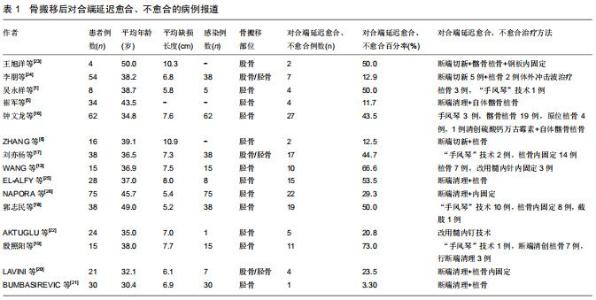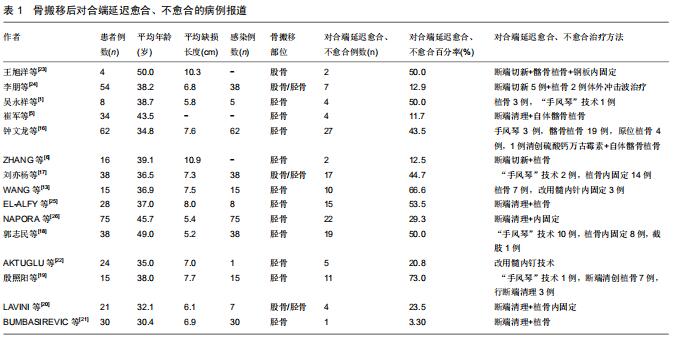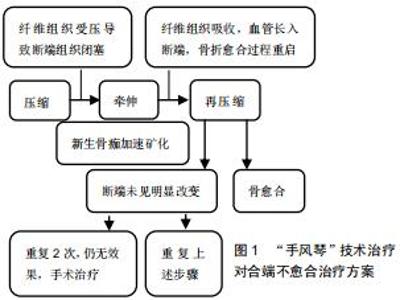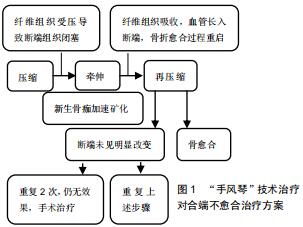|
[1] 吴永祥,黄宗贵,戴海.胫骨骨搬运中骨对合端对位偏差的原因、处理及预防[J].广西医学,2018,40(23):2852-2854.
[2] 上官天丞,郭志民,张萌.骨搬移治疗胫骨骨缺损的研究进展[J].中国中医骨伤科杂志,2016,24(1):78-81.
[3] 叶松林,覃晓峰,李成东,等.骨搬移术治疗胫骨感染性骨不连的疗效[J].实用骨科杂志,2017,23(4):369-371.
[4] 胡居正,石展英,杨成志,等.骨搬移后对合端植骨内固定治疗下肢大段骨缺损的临床研究[J].中华骨科杂志,2018,38(5):280-287.
[5] 崔军,李旭,莫忆南.Ilizarov骨搬移技术治疗创伤性胫骨骨缺损合并软组织缺损的临床研究[J].中国临床医生杂志, 2018,46(9): 1075-1078.
[6] ZHANG Y, WANG Y, DI J, et al. Double-level bone transport for large post-traumatic tibial bone defects: a single centre experience of sixteen cases. Int Orthop. 2018;42(5): 1157-1164.
[7] AKTUGLU K, EROL K, VAHABI A. Ilizarov bone transport and treatment of critical-sized tibial bone defects: a narrative review. J Orthop Traumatol. 2019;20(1):22.
[8] 李高高,谢进,佟义存,等.Ilizarov技术治疗胫骨慢性骨髓炎的临床疗效分析[J].世界最新医学信息文摘,2017,17(99):145-146.
[9] WEN H, YANG H, XU Y. Extreme bone lengthening by bone transport with a unifocal tibial corticotomy: a case report. BMC Musculoskelet Disord. 2019;20(1):555.
[10] BERNSTEIN M, FRAGOMEN A, ROZBRUCH SR. Tibial bone transport over an intramedullary nail using cable and pulleys. JBJS Essent Surg Tech. 2018;8(1):e9.
[11] KANI KK, PORRINO JA, CHEW FS. External fixators: looking beyond the hardware maze. Skelet Radiol. 2020;49(3): 359-374.
[12] 傅德皓.Ilizarov技术治疗胫骨大段感染性骨缺损并发症分析[J].创伤外科杂志,2018,20(7):559-561.
[13] WANG H, WEI X, LIU P, et al. Quality of life and complications at the different stages of bone transport for treatment infected nonunion of the tibia. Medicine (Baltimore). 2017;96(45): e8569.
[14] GARCIA FL, PICADO CH, GARCIA SB. Histology of the regenerate and docking site in bone transport. Arch Orthop Trauma Surg. 2009;129(4):549-558.
[15] LOPEZ-PLIEGO EM, MORA-MACIAS J, GIRALDEZ-SANCHEZ MA, et al. Histological study of the docking site after bone transport. Temporal evolution in a sheep model. Injury. 2018;49(11):1987-1992.
[16] 钟文龙,王新卫,黄鹏程,等.骨搬移治疗胫骨创伤性慢性骨髓炎的效果观察及术后对合端不愈合原因分析[J].中国骨科临床与基础研究杂志,2018,10(4):226-232.
[17] 刘亦杨,沈立锋,张春,等.骨搬移技术治疗下肢长骨干慢性骨髓炎伴骨缺损术后骨性愈合不良的原因分析及对策[J].中国骨伤, 2018,31(6):556-561.
[18] 郭志民,上官天丞,张萌,等.骨搬移治疗胫骨骨缺损相关并发症的防治[J].中国骨伤,2016,29(8):756-760.
[19] 殷照阳,殷建,孙晓,等.Ilizarov骨搬移技术治疗胫骨感染性骨缺损合并软组织缺损[J].重庆医学,2015,44(29):4108-4111.
[20] LAVINI F, DALL'OCA C, BARTOLOZZI P. Bone transport and compression-distraction in the treatment of bone loss of the lower limbs. Injury. 2010;41(11):1191-1195.
[21] BUMBASIREVIC M, TOMIC S, LESIC A, et al. War-related infected tibial nonunion with bone and soft-tissue loss treated with bone transport using the Ilizarov method. Arch Orthop Trauma Surg. 2010;130(6):739-749.
[22] AKTUGLU K, GUNAY H, ALAKBAROV J. Monofocal bone transport technique for bone defects greater than 5 cm in tibia: our experience in a case series of 24 patients. Injury. 2016;47 Suppl 6:S40-S46.
[23] 王旭洋,杨胜松,黄雷,等.保留原锁定接骨板联合Orthofix单边外固定架骨搬移治疗股骨大段骨缺损[J].中医正骨, 2019,31(10): 45-48.
[24] 李朋,刘栋,王兆林,等.骨膜缺如对Ilizarov技术治疗下肢节段性骨缺损的影响[J].中华骨科杂志,2019,39(1):36-34.
[25] EL-ALFY BS. Unhappy triad in limb reconstruction: management by Ilizarov method. World J Orthop. 2017;8(1): 42-48.
[26] NAPORA JK, WEINBERG DS, EAGLE BA, et al. Hexapod frame stacked transport for tibial infected nonunions with bone loss: analysis of use of adjunctive stability. J Orthop Trauma. 2017;31(7):393-399.
[27] LOVISETTI G, SALA F, MILLER AN, et al. Clinical reliability of closed techniques and comparison with open strategies to achieve union at the docking site. Int Orthop. 2012;36(4): 817-825.
[28] FERCHAUD F, RONY L, DUCELLIER F, et al. Reconstruction of large diaphyseal bone defect by simplified bone transport over nail technique: a 7-case series. Orthop Traumatol Surg Res. 2017;103(7):1131-1136.
[29] TETSWORTH K, PALEY D, SEN C, et al. Bone transport versus acute shortening for the management of infected tibial non-unions with bone defects. Injury. 2017;48(10):2276-2284.
[30] 张彦龙,王泳,邸军,等.单平面与双平面截骨骨搬移治疗胫骨大段感染性骨缺损的疗效比较[J].中华创伤杂志, 2017,33(6): 532-538.
[31] 魏奇峰,马克.骨搬移术治疗胫骨骨折术后感染性大段骨缺损的疗效分析[J].中国现代医生,2017,55(15):70-72.
[32] LOVISETTI G, SALA F. Clinical strategies at the docking site of distraction osteogenesis: are open procedures superior to the simple compression of Ilizarov? Injury. 2013;44 Suppl 1:S58-S62.
[33] RIGAL S, MERLOZ P, LE NEN D, et al. Bone transport techniques in posttraumatic bone defects. Orthop Traumatol Surg Res. 2012;98(1):103-108.
[34] HATZOKOS I, STAVRIDIS S I, IOSIFIDOU E, et al. Autologous bone marrow grafting combined with demineralized bone matrix improves consolidation of docking site after distraction osteogenesis. J Bone Joint Surg Am. 2011;93(7):671-678.
[35] ROBINSON PM, PAPANNA M, YOUNIS F, et al. Arthroscopic debridement of docking site in Ilizarov bone transport. Ann R Coll Surg Engl. 2010;92(5):437-438.
[36] SALA F, MARINONI E, MILLER AN, et al. Evaluation of an endoscopic procedure for the treatment of docking site nonunion. J Orthop Trauma. 2013;27(10):569-575.
[37] BIZ C, IACOBELLIS C. Nailing treatment in bone transport complications. Strategies Trauma Limb Reconstr. 2014;9(2): 89-96.
[38] 梁斌,张锴.骨搬移并发症对接点不愈合的研究与进展[J].中国组织工程研究,2018,22(8):1275-1280.
[39] 卢炎君,张永红,王栋,等.手风琴技术治疗胫骨骨折延迟愈合或不愈合[J].中华骨科杂志,2019,39(1):30-35.
|



